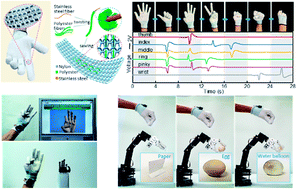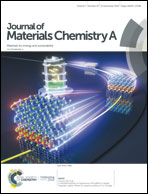An all-textile triboelectric sensor for wearable teleoperated human–machine interaction†
Abstract
Capturing and decoding human motions with textile-based wearables would usher in exciting opportunities for consumer electronics, human–machine interface, and robotics. Transforming textiles into multifunctional materials represents an appealing strategy for implementing human-integrated wearable systems with reconfigurable form factors and designer functions. To this end, significant roadblocks exist primarily due to the challenges in integrating state-of-the-art electronics and power units onto textiles through schemes compatible with the clothing design and processing. Here we present a holistic design and integration of an all-textile triboelectric sensor (ATTS) which is capable of perceiving human motions with a high sensitivity of 1.1 V kPa−1 and a broad pressure-sensitive range from 100 Pa to 400 kPa. The ATTS can be integrated with arbitrary commercial garments. We further demonstrated an ATTS-based smart glove that can capture human gestures for remotely controlling a virtual reality (VR) enabled teleoperated robotic gripper that can dexterously handle delicate objects with a wide range of shapes, sizes, and mechanical properties. Our ATTS technology has the potential for enabling more capable human–machine interfaces and providing dexterity to robots in societally pervasive areas such as teleoperated surgery and advanced manufacturing.



 Please wait while we load your content...
Please wait while we load your content...